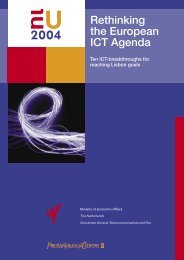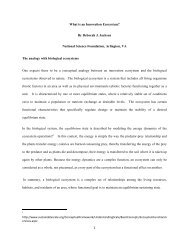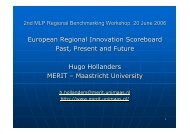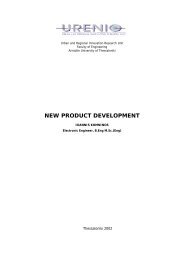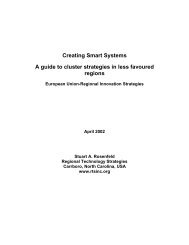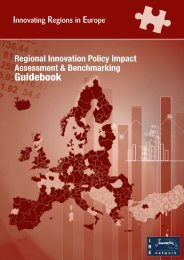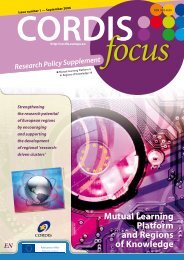EU Industrial R&D Investment Scoreboards 2011
EU Industrial R&D Investment Scoreboards 2011
EU Industrial R&D Investment Scoreboards 2011
Create successful ePaper yourself
Turn your PDF publications into a flip-book with our unique Google optimized e-Paper software.
capture it indirectly, putting forth a relationship between innovation input andoutput and incorporating it into the estimation.This trajectory that goes from research to new products and/or new processesmay be complex. For example, it is quite unlikely that a doubling of theinvestment will double the output, since some of the factors (e.g. skilledworkers) may become scarcer and since the effectiveness may depend on firmcharacteristics, e.g. on the size, if there are fixed costs. Not to mention that timelags should be accounted for.Unfortunately this is not enough, although company level data are necessary tocontrol for the huge amount of heterogeneity, it should be taken into accountthat a company growth is not necessarily equivalent to employment creation. Afirm can grow at the expense of other, less efficient competitors, capturing theirmarket shares. This indirect effect is one of the many spillovers effects relatedwith the accumulation of new knowledge.Using a flexible formulation that account for much of these complications, arecent study by Bogliacino 21 based on a set of data from earlier <strong>Scoreboards</strong>estimated the impact of R&D on employment in form of elasticity, i.e. thepercentage change on labour demand induced by a one percent increase ofR&D. This increase in labour demand will translate into more employmentceteris paribus, i.e. it will depend also on the dynamics of wages (and soultimately depending on institutional factors, bargaining powers and supply ofproper skills).The results of the econometric analysis by Bogliacino show that the elasticity isnot constant with sales. But the interesting result is that it increases with theresearch intensity of companies as follows:• with a research intensity of 1%, doubling the R&D investment will increaselabour demand by a range from 8 to 15%;• with a research intensity of 5%, doubling the R&D investment will increasethe labour demand by 15 to 20%.Employment trendsIn 2010, the Scoreboard companies employed 41.19 million people: 17.09million by <strong>EU</strong>-399 companies; 9.99 million by US-486 companies; 7.12 millionby Japan-230 companies and 6.99 million by OC-162 companies.The number of employees of the 1400 companies increased by 3.0% in 2010compared with a decrease of 1.2% in the year before. These employmentfigures appear less 'elastic' than the rates of growth of R&D and net sales thatincreased more in 2010 (4.0% and 9.4% respectively) but had also decreasedmore in 2009 (-1.9% and -10.1% respectively).21 Bogliacino, F., (2010) "Innovation and Employment: A firm level analysis with European R&D Scoreboard data". IPTS WorkingPapers on Corporate R&D and Innovation (http://iri.jrc.es/papers.htm).60The <strong>2011</strong> <strong>EU</strong> <strong>Industrial</strong> R&D <strong>Investment</strong> Scoreboard



